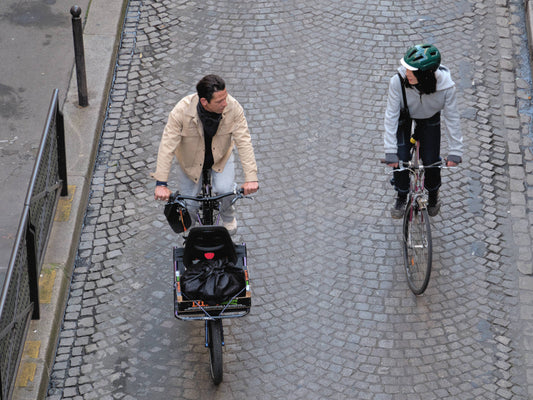impermeability of a bike outfit depends on:
- The water repellency and impermeability of its fabric;
- The impermeability of its seams.
TEXTILE WATER REPELLENCE
The textile of a cycling garment is water repellent when the drops of water "slide" over it, thus preventing them from penetrating inside the textile and therefore the equipment.
Water repellency is not an intrinsic quality of the textile, since it comes from a surface treatment applied to its outer side. Thus the water repellency fades with the duration of exposure to rain and its intensity, but also with wear and washing of rain gear.

The level of water repellency of a textile is defined by the EN ISO 4920 standard and is classified into five levels:
- 100 (ISO 5): Extremely water repellent
- 90 (ISO 4): Very water repellent
- 80 (ISO 3): Water repellent
- 70 (ISO 2) or 50 (ISO 1): Not water repellent
We advise you to choose rainwear with a water repellency of 100 (ISO 5) , which is the case for all TOMO Clothing rainwear .
TEXTILE WATERPROOFING
Unlike water repellency, impermeability of the textile of a bicycle outfit is an intrinsic quality, which can be obtained by integrating a membrane waterproof in the textile, or thanks to a weave specific. The waterproof membrane is generally applied either on the inside face of the textile (against the skin) or between the inside and outside faces of the textile (three-layer textile).
A textile can thus be for example:
- Water repellent but not waterproof (as often are softshells ), in which case water slides off the garment in light and/or short rain, but enters the garment in heavy and/or long rain;
- Not water-repellent but waterproof (membrane) , in which case the outer layer of the textile becomes waterlogged regardless of the intensity and duration of the rain (which may cause a feeling of freshness if the waterproof membrane is in contact with the skin ), but does not penetrate the raincoat;
- Water-repellent and waterproof (membrane) , in which case the outer layer of the textile only gets waterlogged in intense and / or long rain, and does not penetrate the rain poncho under any circumstances.

The level of impermeability of a textile is measured using theSchmerber test , defined by the EN ISO 811 standard , which consists of applying increasing hydrostatic pressure to the textile using an increasingly high water column. The level of impermeability is reached when water penetrates through the textile. It is measured in millimeters of water column height.
In theory, a garment begins to be waterproof when it withstands a water column of 1300 mm (1.3 m), which corresponds to a downpour of medium intensity. However, these values easily go up to 8,000 mm (8m) on a bike due to body movements. We therefore advise you to choose waterproof clothing with a waterproofness greater than 8,000 mm (8m). TOMO Clothing 's rain gear is all waterproof to 10,000mm (10m).
WATERPROOFING OF SEAMS
It is not enough for the textile of a rainwear to be water-repellent and waterproof, because the water also penetrates through the holes drilled in the textile when making the poncho at the seams. We therefore advise you to choose a garment whose seams exposed to the rain are heat-sealed or heat-sealed. with some sealing strips .




